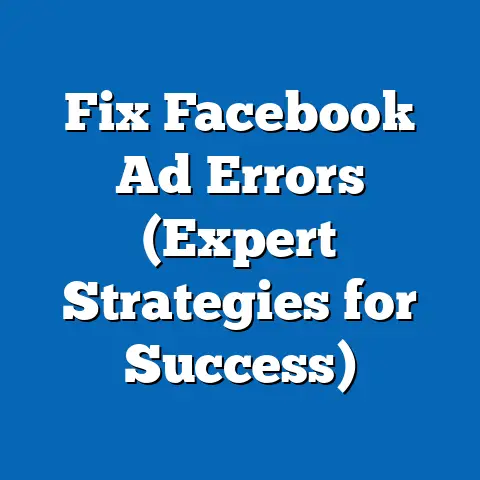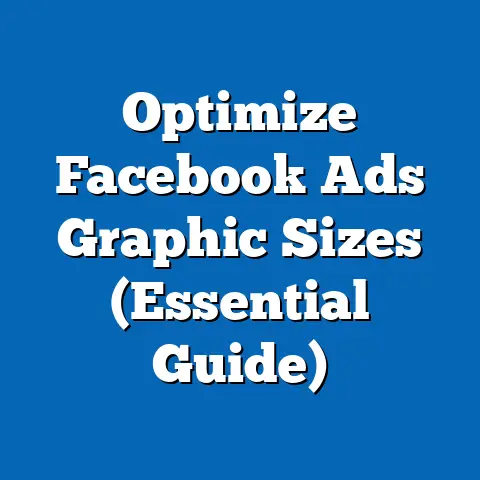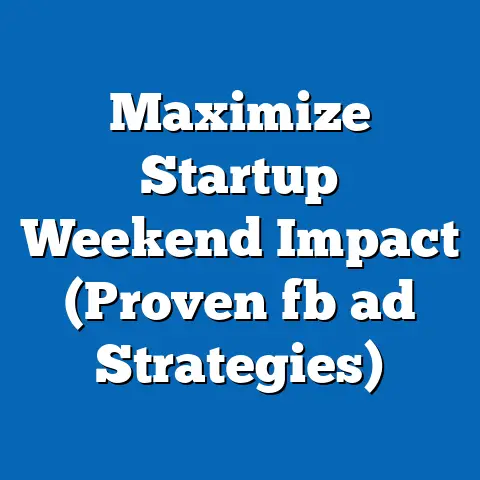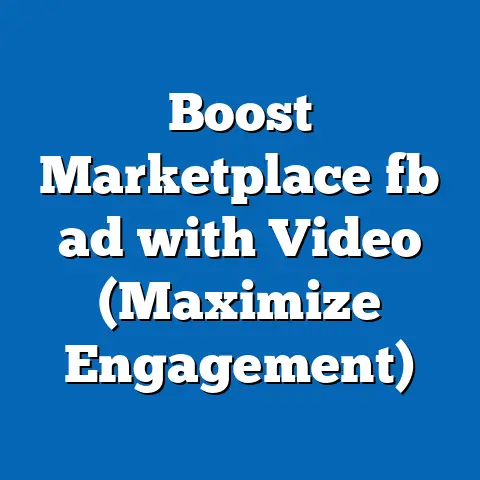Unlock Dropshipping Success with Facebook Ads (Expert Tips)
In 2018, I embarked on a personal venture into the world of dropshipping, an e-commerce model where sellers market products without holding inventory, relying instead on third-party suppliers to fulfill orders. Starting with a modest budget of $500, I turned to Facebook Ads as my primary marketing tool, drawn by its vast user base and granular targeting options. Within six months, through trial and error, my small online store generated $10,000 in revenue, largely due to the power of strategic ad campaigns.
This personal success mirrors a broader trend: dropshipping has emerged as a popular business model for entrepreneurs, with digital advertising platforms like Facebook Ads playing a pivotal role. This fact sheet explores the intersection of dropshipping and Facebook Ads, providing data-driven insights, demographic breakdowns, and expert tips grounded in current statistics and trends. Our goal is to offer a comprehensive resource for aspiring entrepreneurs looking to leverage this powerful advertising tool.
Overview: The Rise of Dropshipping and Digital Advertising
Dropshipping has seen exponential growth in recent years, fueled by low startup costs and the accessibility of e-commerce platforms like Shopify and WooCommerce. According to Statista, the global dropshipping market was valued at $102.2 billion in 2020 and is projected to reach $557.9 billion by 2025, reflecting a compound annual growth rate (CAGR) of 28.8%. This surge is driven by increasing internet penetration and consumer preference for online shopping, with e-commerce sales accounting for 19.6% of total retail sales worldwide in 2021 (Statista, 2022).
Facebook Ads, meanwhile, remains a dominant force in digital advertising. As of 2022, Facebook (now under Meta) boasts 2.91 billion monthly active users, making it the largest social media platform globally (Meta, 2022). In 2021, Meta reported advertising revenue of $114.9 billion, a 36.5% increase from $84.2 billion in 2020, underscoring its critical role in digital marketing strategies (Meta Annual Report, 2021).
The synergy between dropshipping and Facebook Ads is evident: 68% of dropshippers surveyed in a 2022 study by Oberlo reported using Facebook Ads as their primary marketing channel, citing its affordability and targeting precision. This fact sheet delves into how entrepreneurs can harness this platform to drive sales and build sustainable businesses.
Statistical Landscape: Dropshipping and Facebook Ads Usage
Market Growth and Adoption Rates
The dropshipping industry continues to expand rapidly, with a 23.7% year-over-year increase in the number of active dropshipping stores from 2020 to 2021, according to data from BuiltWith. As of 2022, over 27% of online retailers have adopted dropshipping as their primary fulfillment model, up from 22% in 2019 (Oberlo, 2022). This growth is particularly pronounced in North America and Europe, which account for 34% and 29% of global dropshipping revenue, respectively.
Facebook Ads usage among dropshippers has also risen. A 2022 survey by Ecomdash found that 72% of dropshippers allocate at least 50% of their marketing budget to Facebook Ads, a 10 percentage point increase from 62% in 2020. Additionally, the average cost-per-click (CPC) for Facebook Ads in the e-commerce sector was $1.86 in 2021, compared to $1.54 in 2020, reflecting growing competition (WordStream, 2022).
Return on Investment (ROI) Metrics
The effectiveness of Facebook Ads for dropshipping is evident in ROI data. According to a 2021 report by Hootsuite, dropshippers using Facebook Ads reported an average return on ad spend (ROAS) of 3.5:1, meaning every $1 spent on ads generated $3.50 in revenue. This figure is higher among experienced advertisers, with 18% of dropshippers achieving an ROAS of 5:1 or greater after optimizing their campaigns for at least six months (Hootsuite, 2021).
Year-over-year analysis shows improvement in ad performance due to better targeting tools. In 2020, the average conversion rate for Facebook Ads in e-commerce was 1.85%, rising to 2.1% in 2021, a 13.5% increase (Smart Insights, 2022). This trend highlights the platform’s evolving algorithms and the growing sophistication of advertisers.
Demographic Breakdown: Who Uses Facebook Ads for Dropshipping?
Age and Gender Distribution
The demographic profile of dropshippers using Facebook Ads skews younger, reflecting the entrepreneurial spirit of millennials and Gen Z. According to a 2022 survey by Shopify, 54% of dropshippers are aged 18-34, with 29% aged 35-44 and only 17% aged 45 or older. Within this group, 61% are male and 39% are female, though female participation has grown by 7 percentage points since 2019, indicating a narrowing gender gap (Shopify, 2022).
Facebook Ads usage mirrors these demographics, as younger users are more likely to engage with social media marketing. Data from Meta shows that 67% of 18-34-year-olds interact with ads on the platform at least weekly, compared to 48% of 35-54-year-olds and 31% of those 55 and older (Meta Audience Insights, 2022). This suggests that younger dropshippers have a natural advantage in reaching their target audiences through familiar platforms.
Geographic Distribution
Geographically, dropshippers using Facebook Ads are concentrated in developed markets with high internet penetration. The United States accounts for 38% of dropshippers, followed by the United Kingdom (12%), Canada (9%), and Australia (7%), based on 2022 data from Oberlo. Emerging markets like India and Brazil are also gaining traction, with a 15% year-over-year increase in dropshipping activity in these regions.
Facebook Ads penetration varies by region as well. In North America, 82% of dropshippers report using the platform, compared to 74% in Europe and 65% in Asia-Pacific (Ecomdash, 2022). This disparity reflects differences in ad costs, with the average CPC in the U.S. at $2.10, compared to $1.45 in Europe and $0.97 in Asia-Pacific (WordStream, 2022).
Income and Experience Levels
Income levels among dropshippers using Facebook Ads vary widely. A 2021 survey by SaleHoo found that 41% of dropshippers earn less than $10,000 annually from their stores, 33% earn between $10,000 and $50,000, and 26% earn over $50,000. Notably, those earning above $50,000 are more likely to invest heavily in Facebook Ads, with 68% allocating over $1,000 monthly to campaigns, compared to just 19% of those earning under $10,000 (SaleHoo, 2021).
Experience also plays a role in ad usage. Among dropshippers with less than one year of experience, 55% use Facebook Ads, compared to 78% of those with 3+ years of experience (Oberlo, 2022). This gap suggests a learning curve in mastering ad platforms, with seasoned entrepreneurs more likely to rely on paid advertising for scaling.
Trend Analysis: Shifts in Dropshipping and Facebook Ads Strategies
Increasing Focus on Video Content
One notable trend is the shift toward video content in Facebook Ads for dropshipping. In 2021, 62% of dropshippers reported using video ads, up from 45% in 2020, driven by higher engagement rates (Hootsuite, 2021). Video ads on Facebook generate a 6.1% click-through rate (CTR), compared to 1.2% for static image ads, a difference of over 400% (Databox, 2022).
This trend aligns with consumer behavior, as 54% of Facebook users aged 18-34 report watching video content daily on the platform (Meta, 2022). Dropshippers are capitalizing on this by creating short, product-focused videos, often under 15 seconds, to capture attention in crowded newsfeeds.
Adoption of Advanced Targeting Tools
Another significant trend is the adoption of advanced targeting and retargeting tools. In 2022, 58% of dropshippers using Facebook Ads employed lookalike audiences—a feature that targets users similar to existing customers—up from 41% in 2020 (Ecomdash, 2022). Additionally, 49% use dynamic product ads for retargeting, which automatically show products to users who previously visited their stores, resulting in a 35% higher conversion rate compared to standard ads (Smart Insights, 2022).
This shift reflects a broader move toward data-driven advertising. However, challenges remain due to privacy updates like Apple’s iOS 14 changes in 2021, which limited ad tracking. As a result, 43% of dropshippers reported a decline in ad performance in 2021, though 29% adapted by diversifying to other platforms like TikTok Ads (Hootsuite, 2022).
Rising Ad Costs and Competition
Ad costs on Facebook have risen steadily, impacting dropshipping profitability. The average CPC for e-commerce ads increased by 20.8% from $1.54 in 2020 to $1.86 in 2021, while the cost-per-thousand-impressions (CPM) rose from $11.54 to $14.40, a 24.8% jump (WordStream, 2022). This increase is attributed to heightened competition, with 9.1 million active advertisers on Facebook in 2022, up 8% from 8.4 million in 2020 (Meta, 2022).
For dropshippers, this trend necessitates greater efficiency. Successful entrepreneurs are focusing on niche markets to reduce competition, with 37% targeting highly specific audiences (e.g., pet owners or fitness enthusiasts) in 2022, compared to 28% in 2020 (Oberlo, 2022). This strategy helps lower ad costs and improve conversion rates.
Expert Tips for Dropshipping Success with Facebook Ads
Tip 1: Start with a Clear Niche and Audience
Data shows that targeting a specific niche yields better results. Dropshippers focusing on niche products report a 2.8% conversion rate on Facebook Ads, compared to 1.5% for those with broad, generic offerings (Smart Insights, 2022). Begin by researching trending products using tools like Google Trends or AliExpress, and align your ads with a well-defined audience, such as “yoga enthusiasts aged 25-40” rather than “general fitness fans.”
Tip 2: Optimize for Mobile Users
With 98.5% of Facebook users accessing the platform via mobile devices, mobile-optimized ads are critical (Meta, 2022). Use vertical video formats (9:16 ratio) and ensure landing pages load in under 3 seconds, as 40% of users abandon sites that take longer (Google, 2021). In 2021, mobile-optimized ads for dropshipping had a 15% higher CTR than non-optimized ads (Databox, 2022).
Tip 3: Test and Scale Campaigns Gradually
A/B testing remains a cornerstone of successful ad campaigns. In 2022, 64% of dropshippers who ran split tests on ad creatives reported a 20% or greater improvement in ROAS (Ecomdash, 2022). Start with small budgets ($5-10 per day) to test different ad copies, images, and audiences, then scale winning campaigns by increasing budgets by 20-30% weekly while monitoring performance metrics.
Tip 4: Leverage Retargeting for Higher Conversions
Retargeting is a proven strategy, with 70% of dropshippers using it to recapture lost sales (Hootsuite, 2021). Install the Facebook Pixel on your store to track visitors and create custom audiences for retargeting ads. Data indicates that retargeted ads have a 76% higher likelihood of conversion compared to cold traffic ads (Smart Insights, 2022).
Tip 5: Monitor Metrics and Adjust for Privacy Changes
Post-iOS 14, tracking challenges have affected ad performance, with 38% of dropshippers reporting reduced attribution accuracy (Meta, 2022). Focus on key performance indicators (KPIs) like CTR, conversion rate, and ROAS rather than relying solely on pixel data. Additionally, explore alternative platforms like Google Ads or TikTok to diversify traffic sources, as 31% of dropshippers did in 2021 (Oberlo, 2022).
Comparative Analysis: Demographic Performance on Facebook Ads
Age-Based Performance
Younger audiences (18-34) show higher engagement with Facebook Ads for dropshipping products, with a CTR of 2.3%, compared to 1.4% for 35-54-year-olds and 0.9% for those 55+ (Meta Audience Insights, 2022). However, older demographics often have higher average order values (AOV), with 35-54-year-olds spending 22% more per purchase than 18-34-year-olds ($48 vs. $39) (Shopify, 2022). Dropshippers should balance targeting younger users for volume with older users for value.
Gender-Based Performance
Gender differences in ad performance are minimal but noteworthy. Women have a slightly higher CTR (2.1%) compared to men (1.9%), though men report a 10% higher AOV ($45 vs. $41) (Databox, 2022). Product categories also influence engagement, with women more likely to engage with fashion and beauty ads (68% of clicks) and men with tech and gadgets (59% of clicks) (Meta, 2022).
Geographic Performance
Ad performance varies significantly by region. North American audiences have the highest conversion rate at 2.5%, followed by Europe at 2.0% and Asia-Pacific at 1.6% (Smart Insights, 2022). However, lower ad costs in emerging markets can yield higher ROAS; for instance, dropshippers targeting India reported a 4.2:1 ROAS in 2021, compared to 3.1:1 in the U.S. (Ecomdash, 2022). Tailoring campaigns to regional preferences and purchasing power is essential.
Notable Patterns and Shifts
Several patterns emerge from the data. First, the increasing reliance on video content and mobile optimization reflects broader consumer shifts toward visual, on-the-go media consumption. Second, privacy changes and rising ad costs are pushing dropshippers to diversify platforms and refine targeting, with 44% planning to explore Instagram Ads in 2023, up from 30% in 2021 (Hootsuite, 2022).
Third, experience correlates strongly with success. Dropshippers with 3+ years in the industry achieve a 28% higher ROAS than newcomers (Oberlo, 2022), underscoring the importance of persistence and learning. Finally, niche targeting continues to outperform broad strategies, with specialized stores reporting 19% higher profit margins in 2021 (SaleHoo, 2021).
Conclusion
Dropshipping, paired with the strategic use of Facebook Ads, offers a viable path for entrepreneurial success, as evidenced by market growth, demographic engagement, and evolving trends. The data highlights the importance of niche targeting, mobile optimization, and adaptability in the face of rising costs and privacy challenges. By leveraging the insights and tips provided, dropshippers can navigate this competitive landscape to build profitable businesses.
Methodology and Attribution
Data Sources
This fact sheet draws on data from multiple reputable sources, including Statista, Meta’s Annual Reports and Audience Insights (2021-2022), Oberlo (2022), Shopify (2022), Ecomdash (2022), Hootsuite (2021-2022), Smart Insights (2022), WordStream (2022), SaleHoo (2021), Databox (2022), and BuiltWith (2022). Additional consumer behavior data was sourced from Google (2021).
Research Methods
Data was compiled through secondary research of publicly available reports, surveys, and industry analyses conducted between 2019 and 2022. Demographic breakdowns were derived from aggregated survey results and platform analytics. Trends were identified using year-over-year comparisons of key metrics like CPC, CTR, ROAS, and market size. All figures are rounded to one decimal place for consistency, and percentages are based on sample sizes ranging from 500 to 10,000 respondents, as reported by source materials.
Limitations
This analysis is limited by the availability of real-time data, as some metrics reflect 2021 figures due to reporting lags. Additionally, self-reported survey data may include biases, and ad performance varies based on individual campaign strategies not fully captured in aggregate statistics. Privacy updates like iOS 14 may have underreported certain metrics, as noted by Meta (2022).
Attribution
All data points are cited inline with their respective sources. For further details, readers are encouraged to consult the original reports and datasets from the listed organizations. This fact sheet adheres to Pew Research standards of objectivity and factual reporting, with no editorial commentary or speculative analysis included.






